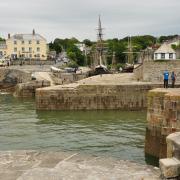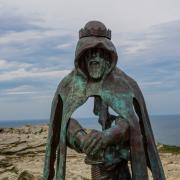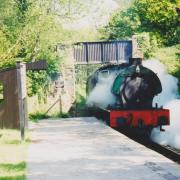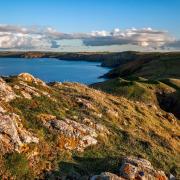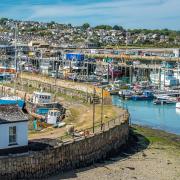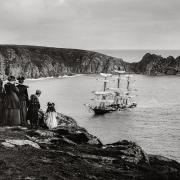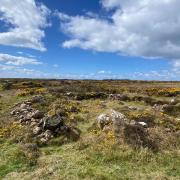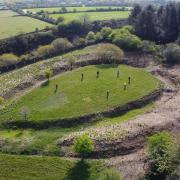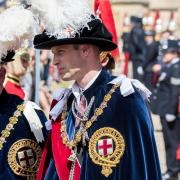This month, photographer David Chapman focuses his lens on some of our most mysterious and familiar landmarks, which have stood on, and in the Cornish landscape for thousands of years.
Barrows and quoits might sound like things you find in the garden but they are probably the most moving and atmospheric historic monuments we have from the Neolithic and Bronze Age periods.

So what are quoits?
Quoits, also known in various parts of Britain as dolmens and cromlechs, are thought to date from around 3700 to 3000 BC, that is during the Neolithic period. Although no bones have ever been found in Cornish quoits, other similar structures around the country have revealed evidence of burials.
Quoits are free-standing stone structures often with a very large internal cavity and a huge flat stone on top. Apart from being a place where bodies, or at least bones, were placed there may well have been other purposes for quoits but we cannot be sure.
And barrows?
From the outside barrows are simply mounds of earth. Their purpose is probably quite complex and might well have varied through time. Evidence seems to suggest that they were first created in around 3000 BC (around the end of the Neolithic period) and they were used for a variety of ritual purposes including burials. It is possible that barrows were used to bury significant people along with their belongings (my mind is taken to Sutton Hoo in Suffolk) though they might also have been used as places of worship.
Quoits, and maybe barrows, seem to have been superseded by chambered cairns, most of which are probably Bronze Age (3000 to 1200 BC, approx). They were formed using standing stones to create often quite small spaces. These stones were capped with large flat stones or sealed with other stonework before being banked up with earth to seal them in except for an entrance. The entrance was usually very small and sometimes its alignment has suggested a connection with the rising of the sun at certain times of year. The fact that these structures had an entrance has led to them being referred to as ‘entrance graves’.

Where to find them
The best examples of such ancient structures are in those areas of the county that have never been ploughed or developed. So the best areas are West Penwith, the Isles of Scilly, The Lizard and Bodmin Moor.
Ballowall Barrow is a barrow containing a huge, chambered tomb at Carn Gloose, near St Just. It is truly unique, being far more complex than any other of its type in Cornwall. It is thought to have begun in the Neolithic period and was still being used throughout the Bronze Age.

Chapel Carn Brea is a hill in the far west of Penwith, near Land’s End airport. Atop this distinctive landmark is a selection of about ten barrows with a couple that can be recognised as burial cairns. It isn’t so much the remains that make this place special as the view from the summit which extends to Land’s End and the Isles of Scilly.

Chûn Quoit is regarded as the best-preserved quoit in West Cornwall. It is thought to have retained its capstone in the original position since it was built about 5,000 years ago! The name Chûn is derived from the Cornish, Chy an Woone, meaning ‘House on the Downs’ and it is situated high on the moors above Morvah.

Lanyon Quoit is the most visited of the quoits in West Penwith because it is adjacent to a road (between Madron and Morvah). It is said that the capstone was once tall enough to allow a horse and rider to pass underneath, but it was dislodged during a thunderstorm in 1815. Subsequently it was re-erected, but one of the standing supports had broken so now it stands on three, not four, stones.

Trethevy Quoit is near St Cleer, on the southern edge of Bodmin Moor. This is an impressive quoit standing almost three metres tall with a huge capstone held aloft by five standing stones.
The Isles of Scilly
According to English Heritage, of the 93 entrance graves found in England 79 are on the Isles of Scilly (the rest are in West Cornwall). Here are some of the best from around the islands.

At Innisidgen, near Bar Point, St Mary’s, there are two entrance graves. The upper site is one of the best-preserved entrance graves on the islands and sits within a mound measuring some nine metres long.

Obadiah’s Barrow on Gugh, was excavated by a man called George Bonsor in 1901, he found 13 burials including 12 cremations, and he named it after Obadiah Hicks of St Agnes. This is an entrance grave with a short entrance passage and an inner chamber measuring about five metres by one and a half. There are four slabs across the top.

Buzza Hill Chambered Tomb is found on the hill beside Buzza Tower, overlooking Hugh Town. Little is known about this tomb but it is in a great location for photography with wonderful views over the town.

At Work’s Carn on Bryher there is a beautiful view of Rushy Bay and Cruther’s Hill on St Martin’s offers views along Higher Town Bay and St Martin’s Flats.

David's photography tips
Ballowall Barrow is a wonderful location for photography as it is situated on a headland with a great view of the coast including Sennen Cove and even the Isles of Scilly.
Photographically, the scattered boulders at Chapel Carn Brea can be used to make a distinctive foreground in a scene which will include far-reaching views.
The moorland surrounding Chûn Quoit comes alive in late summer with the flowers of heather and western gorse, as well as a beautiful selection of grasses, making this the best time to photograph it.
Lanyon Quoit is easy to get to, so a good one for photographing at night.

To photograph Trethevy Quoit I suggest a wide-angle lens from a very low angle.

The entrance graves at Innisidgen are situated in a commanding position with views over the sound to the islands of St Martin’s and Tresco. The higher site is on top of a ridge, so to get photos I hold my camera high above my head to get a higher viewpoint.
Obadiah’s Barrow can make a good photo at sunset, I use a neutral density graduated filter to help darken the sky.
To see more of David’s photography visit his website at www.davidchapman.org.uk or look out for his book ‘Photographing Cornwall’ available in all local bookshops.





